
As the Stadium Neighbourhood planning process enters Phase 2, the Neighbourhood’s outline is starting to become clear — residents want a sustainable, affordable community that will connect the academic campus with Wesbrook Village and wellbeing areas like the nearby UBC Botanical Garden and athletic and recreational facilities.
“Stadium Neighbourhood is a great site for starting to knit South Campus together,” says Gerry McGeough, Director of Planning and Design for Campus and Community Planning.
He’s standing on East Mall looking west towards Thunderbird Stadium and the sea beyond. The parking lot in front of him is a muddy mess. To his right are the tall fir trees of Rhododendron Wood and Hawthorn Place; to his left the cranes and new apartment complexes of Wesbrook Village.
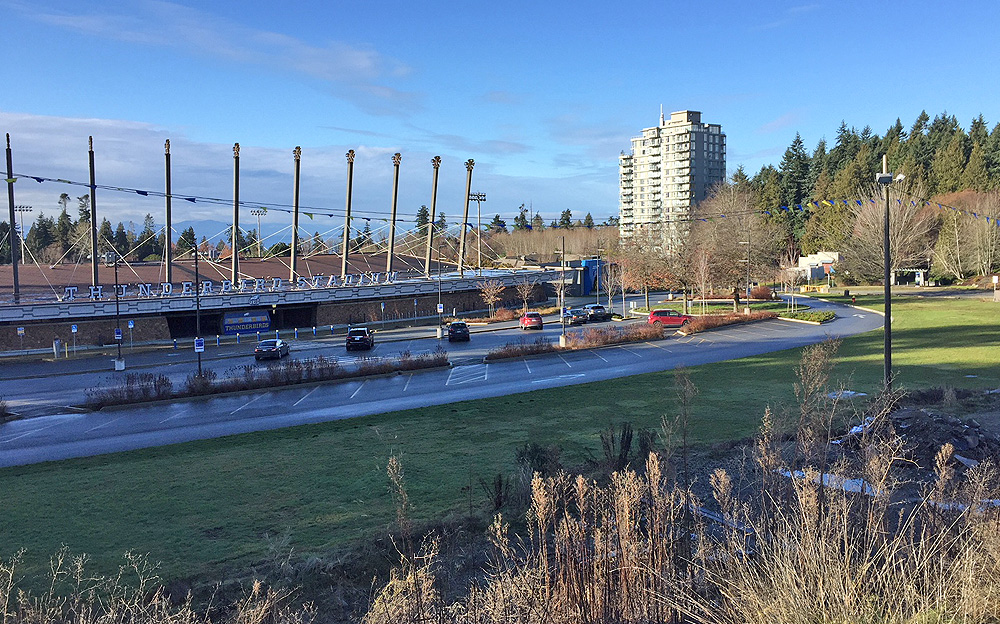
The view looking west from the site of the new Stadium Neighbourhood. Thunderbird Stadium and the Hawthorn Place Neighbourhood are seen in the background.
After an intense initial phase of consultation—almost 1600 comments were received, more than 160 people attended three open houses, 288 people answered an online survey and another 300 were engaged by 16 pop-op events—the planning department is moving forward with Phase 2 of the development of a neighbourhood plan for this new neighbourhood.
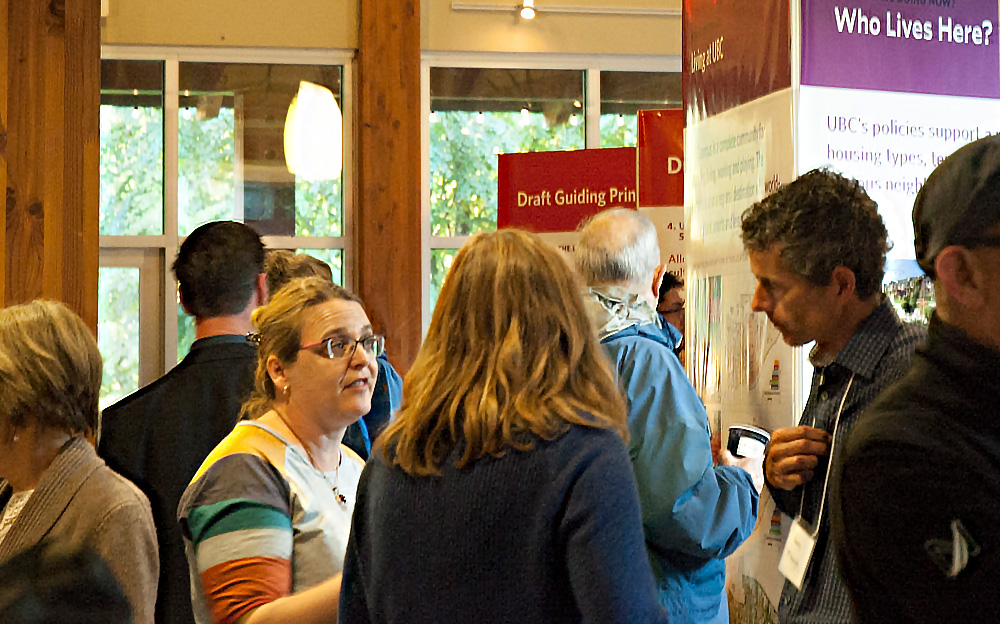
Gerry McGeough, Director of Planning and Design for Campus and Community Planning, listens to residents at a Stadium Neighbourhood open house meeting in October 2017.
“We’ve had substantive, thoughtful feedback from the community, and their needs and aspirations are starting to come together,” McGeough says. “Right now, Wesbrook is separated from the rest of campus. Stadium Neighbourhood will provide a nice pedestrian route through to the academic core, and vice versa, like a belt buckle pulling Wesbrook together with the rest of campus.”
Affordable Housing for the University Community
“Targeting affordable housing for the whole university community—faculty, staff and students—is a priority for this neighbourhood,” says McGeough. This will include below-market rental and condominiums. The site’s proximity to the academic core will make these much-needed offerings especially attractive to people who work at UBC, so they can also live and play on campus.
“We will be looking at the housing needs of the community: families, staff and grad students,” explains McGeough. “We’re asking, where are there gaps in the supply, and how can we fill them?”
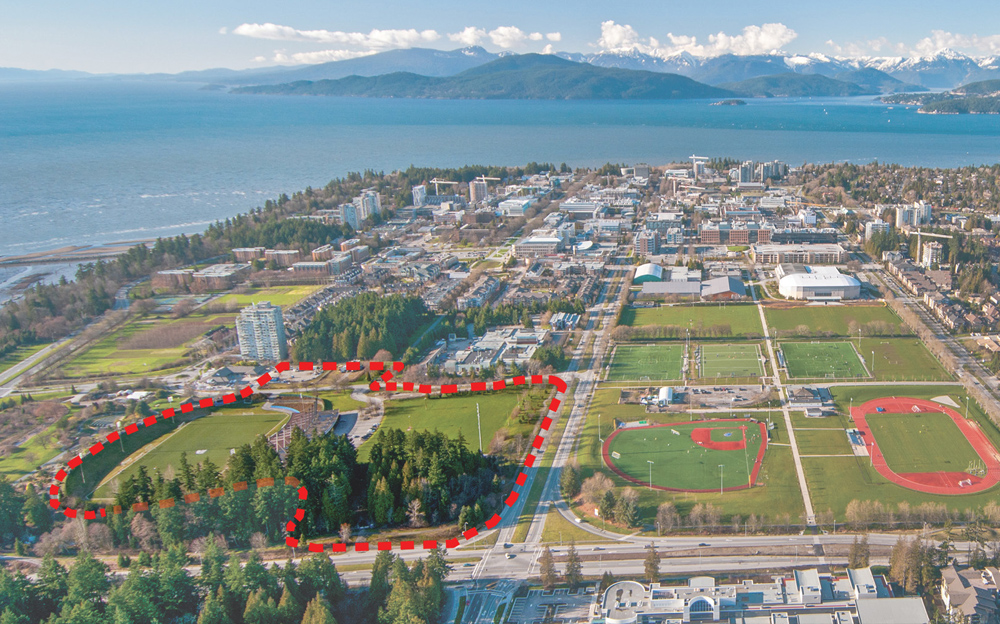
An aerial photo of UBC shows the site of the future Stadium Neighbourhood on the lower left.
“As the university adds new population to the area, we will also look at creative solutions with our transportation staff,” says McGeough. “How do we make it much easier for people to walk and cycle or use transit?”
This involves looking at bus routes across campus, to better connect neighbourhood residents to the bus hub and academic core. Another consideration is penciling in a second Skytrain stop on South Campus, for the day when the region’s rapid transit network extends to UBC.
Greenways and Services
“There’s a wonderful greenway that goes right through the site,” notes McGeough. He’s standing by Rhododendron Wood just north of the 22-acre development area.
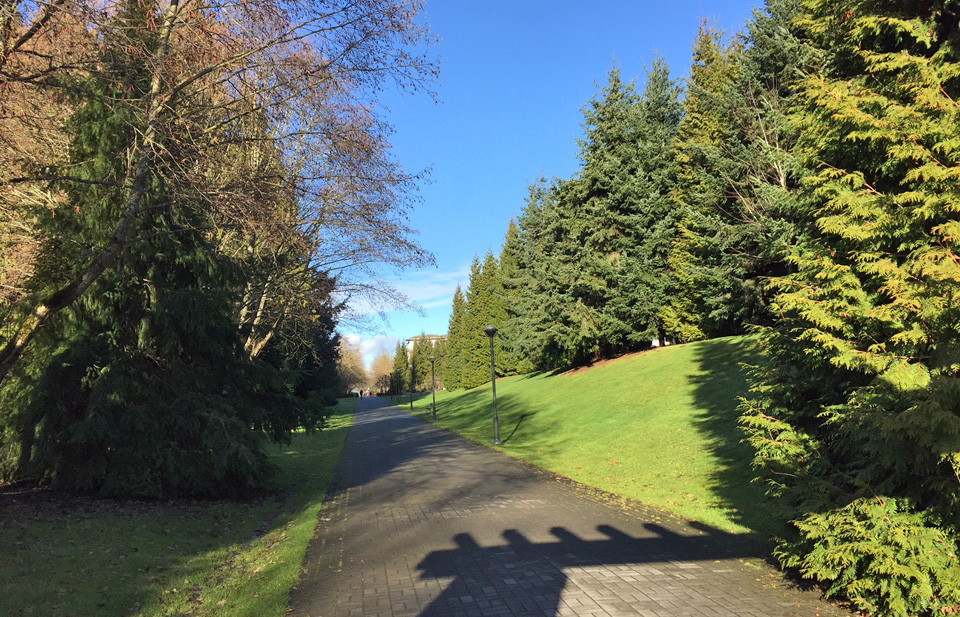
The Main Mall Greenway between Stadium Road and Thunderbird Boulevard runs along the stand of trees known as Rhododendron Wood in Hawthorn Place.
“It runs from Pacific Spirit Park, past the Farm and then straight down Main Mall all the way to the view of the ocean at the Rose Garden. Linking the two at Stadium Neighbourhood would create a world-class connector between the bustling cultural mall and the park-like promenade of the Main Mall Greenway. It would connect our natural setting with various cultural facilities—the Reconciliation Pole, Beaty Biodiversity Museum, Chan Centre, Museum of Anthropology, and many more—to create a landmark destination spanning from the lush forest of Pacific Spirit Regional Park to the Pacific Ocean. A pedestrian route that links up an extensive part of the traditional land of the Musqueam people.”
Stadium Neighbourhood will also be linked to the rest of campus by a second corridor, East Mall. “This avenue is less understood, but has the potential to be an active, safe people connector between Wesbrook Place and the academic campus,” says McGeough.
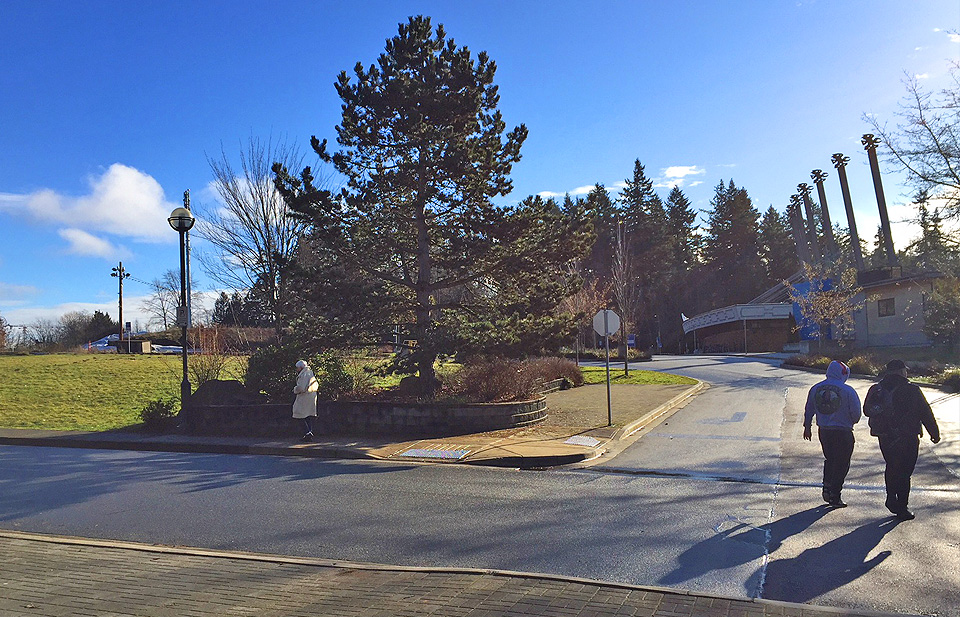
Looking south towards the future site of the Stadium Neighbourhood from Stadium Road.
“A healthy neighbourhood has an active main street that supports socializing and propels it. In the coming months we will be working with the community to define East Mall’s character. There’s an opportunity to explore evolving it into a well-used ‘local street’ for moving pedestrians and cyclists north and south on campus. The question we’re asking is, how do you make it a safe, local, comfortable connector?”
“With the campus community and Properties Trust, we’ll be exploring how to best serve the daily needs of residents, so they don’t have to drive off campus to get all they need. What is missing and would complement Wesbrook Place when it comes to amenities and services: a fruit and vegetable store, a place for a massage, shoe repair? Our goal is to create a community with everything and anything people need. All within walking distance.”
Green Space and Recreational Facilities
A new football stadium will be built within the neighbourhood, which adds both challenges and opportunities. “To be successful, it will need to be an integral part of the neighbourhood,” McGeough explains. “The siting could change; it may be rebuilt in a new configuration, or we may move it entirely. We do know that it will be more compact, which will free up more land for neighbourhood development, and help pay for the new stadium.”
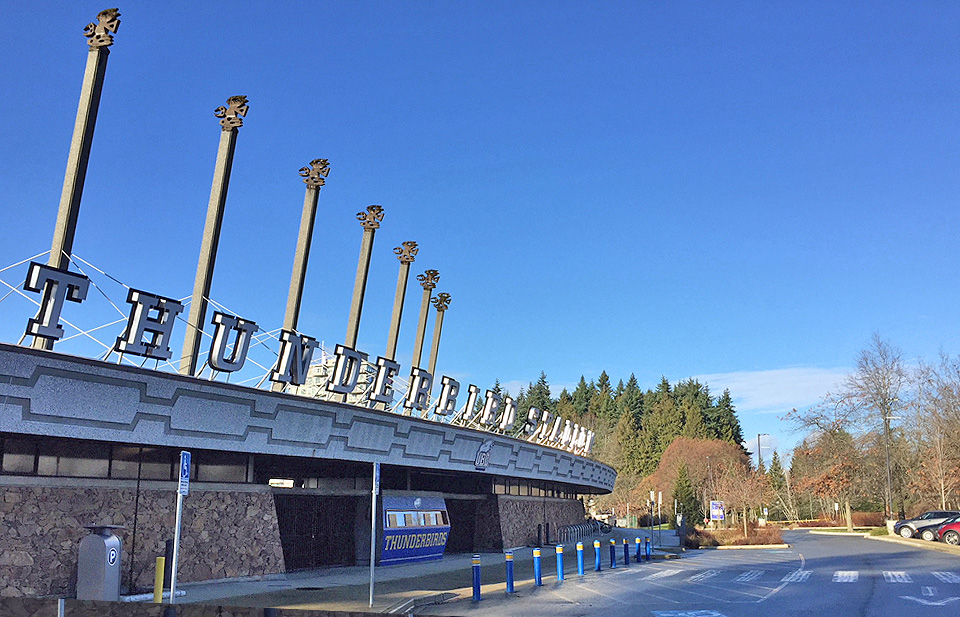
Looking towards the entrance of Thunderbird Stadium.
The area will be right next to UBC’s world-class suite of athletic and community recreational facilities, which will help define the neighbourhood’s character. “Campus and Community Planning is already working with the University Neighbourhoods Association to make many athletic facilities and programs available to residents, like soccer, baseball, tennis, etc,” says McGeough. “We want to take advantage of the new athletic infrastructure to serve residents and support their wellbeing.”
The neighbourhood will also be an opportunity to better connect the campus to some wonderful natural assets: Rhododendron Wood, UBC Botanical Garden, and the forest and coastline beyond.
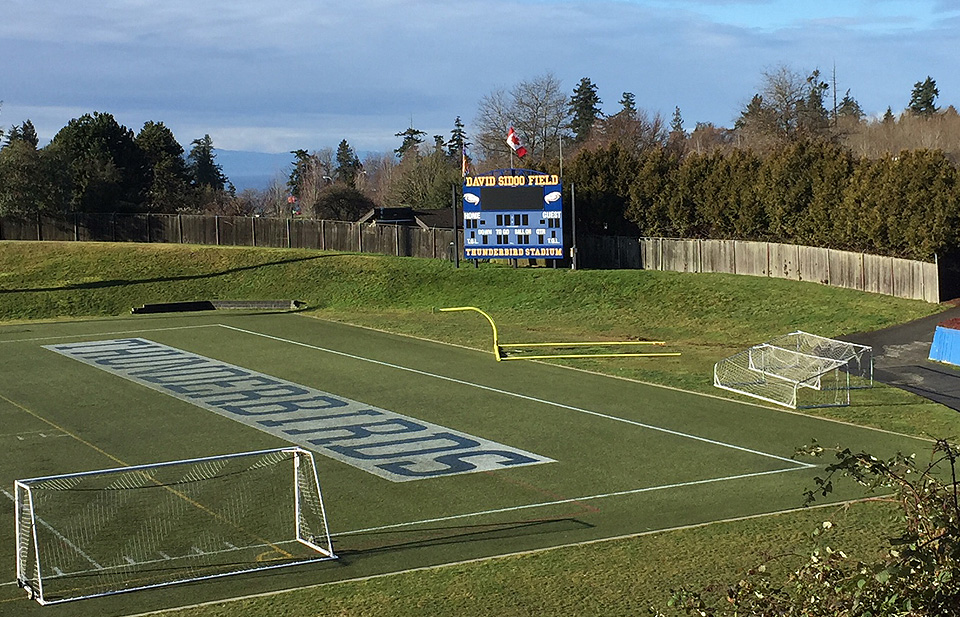
The view from the stands at Thunderbird Stadium looking west towards the ocean.
“The site is surrounded by a rich ecosystem — how can new developments contribute to that through green roof and ecologically rich streetscapes?” asks McGeough. “The knowledge and expertise of the UBC Botanical Garden and other academics, can that play a role? Can the rich ecology of the surrounding area be a net contributor to campus sustainability and bioservices, even with all this new development?”
The site slopes towards the ocean, so the community is keen to get views for all the new residents, perhaps including communal rooftop gardens so everyone can enjoy the forest and ocean beyond.
“One community member called it making the view democratic,” says McGeough.
Getting Feedback on Big Ideas
So what are the next steps in the 18-month planning process? First, at the end of January, UBC will hold a charrette: a planning process involving the community Planning Advisory Committee and staff and faculty subject experts.
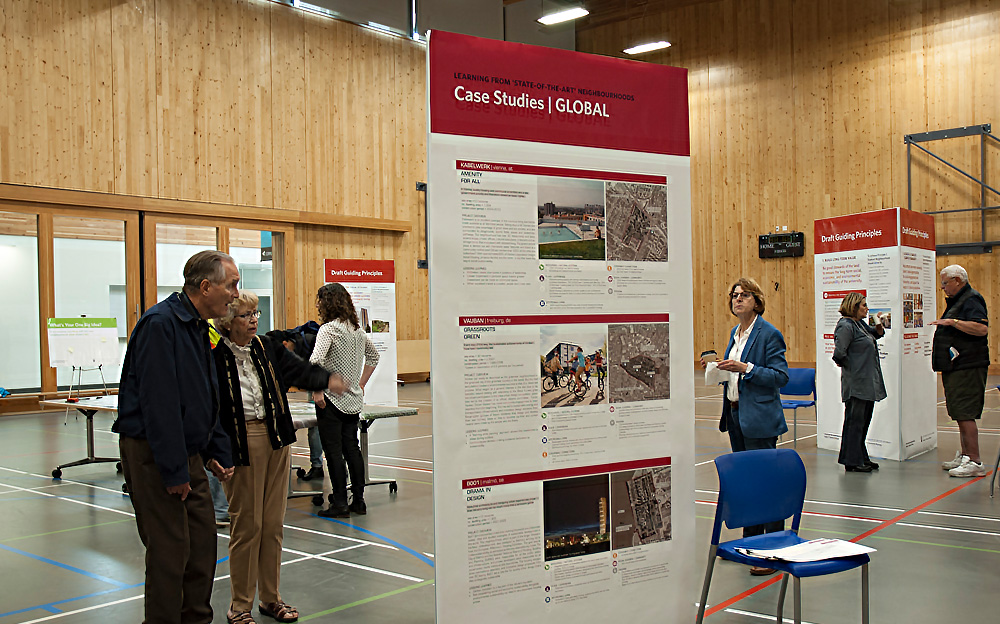
Residents attend an open house for the Stadium Neighbourhood at Wesbrook Community Centre in September 2017.
“It’s a week of integrated thinking and planning guided by the neighbourhood planning principles and parameters adopted by the Board of Governors,” explains McGeough, “with an excellent composition of stakeholders and expertise. Then we’ll be engaging the whole community at the end of March and beginning of April in a second phase of consultation, to get feedback on the big ideas and planning frameworks that emerge. We’ll also be holding community workshops, to envision the sorts of environments/experiences people would like to have in this future community.”
It will be five to seven years before ground is broken on the development, but the vision for Stadium Neighbourhood will soon be taking shape.